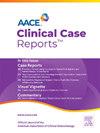甲巯咪唑所致粒细胞缺乏症伴甲状腺毒性周期性麻痹一例。
IF 1.2
Q3 Medicine
引用次数: 0
摘要
背景/目的:甲状腺毒性周期性麻痹(TPP)是一种罕见的疾病,引起下肢无力并伴有明显的低钾血症。同样,使用甲巯咪唑引起的粒细胞缺乏症也很少见。我们提出了第一个记录的病例伴随TPP和粒细胞缺乏症从甲巯咪唑的使用。病例报告:一名48岁女性,表现为喉咙痛、发热、咽痛和突然发作的双侧腿无力。甲巯咪唑在格雷夫斯病新诊断前10周开始使用。入院时,患者出现发热、心动过速、甲状腺毒性和中性粒细胞减少。她还经历了下肢几乎瘫痪的经历。她被诊断为TPP,并接受β -阻断治疗。她住进重症监护室,并开始使用广谱抗生素、锂和普萘洛尔分别治疗感染性休克和甲状腺功能亢进。治疗2天后仍持续低钾血症,她还被诊断为再进食综合征。讨论:TPP是一种罕见的疾病,但对于任何表现为突然虚弱的甲状腺毒性患者,应考虑其鉴别。如果相关的低钾血症在β阻断48小时内没有开始正常化,则应调查其他病因。最后,替代疗法如锂可用于控制甲巯咪唑诱导的粒细胞缺乏症患者的甲状腺功能亢进。结论:甲巯咪唑引起的粒细胞缺乏症和甲状腺毒性周期性麻痹是单独罕见的诊断,两者合并是极其罕见的,我们的病例是文献中第一例同时患有这两种症状的患者。本文章由计算机程序翻译,如有差异,请以英文原文为准。
A Rare Case of Thyrotoxic Periodic Paralysis in a Patient With Concomitant Methimazole-Induced Agranulocytosis
Background/Objective
Thyrotoxic periodic paralysis (TPP) is a rare condition causing weakness of the lower extremities associated with significant hypokalemia. Likewise, agranulocytosis due to methimazole use is a rare occurrence. We present the first documented case of concomitant TPP and agranulocytosis from methimazole use.
Case Report
A 48-year-old woman presented with sore throat, fevers, odynophagia, and sudden-onset bilateral leg weakness. Methimazole had been started 10 weeks prior for a new diagnosis of Graves’ disease. On admission, the patient was febrile, tachycardic, thyrotoxic, and neutropenic. She also experienced near-paralysis of the lower extremities. She was diagnosed with TPP and treated with beta blockade. She was admitted to the intensive care unit and started on broad-spectrum antibiotics, lithium, and propranolol for treatment of septic shock and hyperthyroidism, respectively. Given persistent hypokalemia despite 2 days of therapy, she was also diagnosed with refeeding syndrome.
Discussion
TPP is a rare entity, though it should be considered on the differential for any thyrotoxic patient presenting with sudden weakness. If the associated hypokalemia does not begin to normalize within 48 h of beta blockade, other etiologies should be investigated. Lastly, alternative treatments such as lithium may be used to control hyperthyroidism in patients with methimazole-induced agranulocytosis.
Conclusion
While methimazole-induced agranulocytosis and thyrotoxic periodic paralysis are independently rare diagnoses, the combination of the 2 is exceedingly rare, and our case represents the first documented case in the literature reflecting a patient suffering from both syndromes.
求助全文
通过发布文献求助,成功后即可免费获取论文全文。
去求助
来源期刊

AACE Clinical Case Reports
Medicine-Endocrinology, Diabetes and Metabolism
CiteScore
2.30
自引率
0.00%
发文量
61
审稿时长
55 days
 求助内容:
求助内容: 应助结果提醒方式:
应助结果提醒方式:


